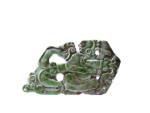Category
Maya Pendants
Maya culture extended through the Yucatan Peninsula, the state of Chiapas in Mexico, Guatemala, Belize and western Honduras. Jade pendants were crafted between the late Pre-Classic and Post-Classic periods from 400 BC to 1200 AD. They were used as necklaces, pectorals, pendants or amulets. They have been found in various places but the most elaborate jade pieces are issued from the tombs of highranking personages. They can be found as elements in a necklace or accompanied by polished, decorated tubular beads of the same material. They are easily identified due to their green shades, polished surface and small size. Maya plaques were made of jade or other similar stones such as serpentine in varying shades of cream and green. Their size varies but they are usually small, measuring between 5 and 15 cm. Beads are 3 to 7 cm. Pendants have irregular shapes as the decorative motifs had to be adapted to the shape and size of the original stone. They are perforated and decorated on one side by means of incisions or sculpture in the round. Human figures, portrayed from the front or the side, in sitting or standing position, are one of the most popular motifs. Modes of depiction vary greatly ranging from a head with the typical Maya profile and a sophisticated head-dress or a body figure extremely simple in its representation and dress. Late items are much more elaborate and sometimes have incised scenes such as a lavishly dressed character with or without inscriptions accompanied by secondary characters. Other depictions include grotesque human figures, animals and abstract elements such as sculpted in the round or incised hieroglyphic inscriptions. Tubular beads can be plain or decorated.

